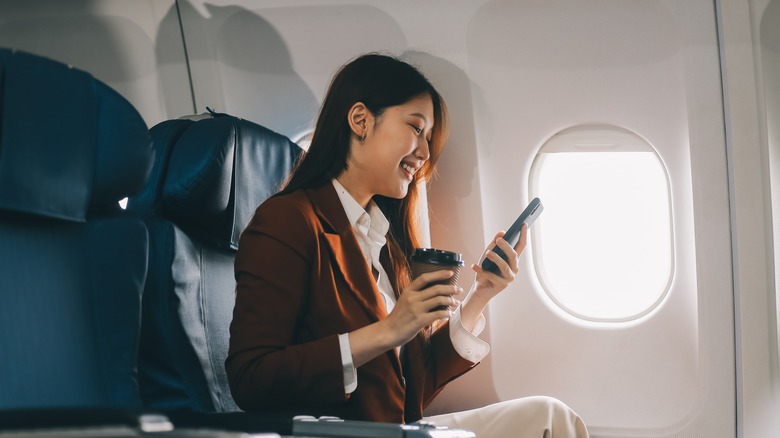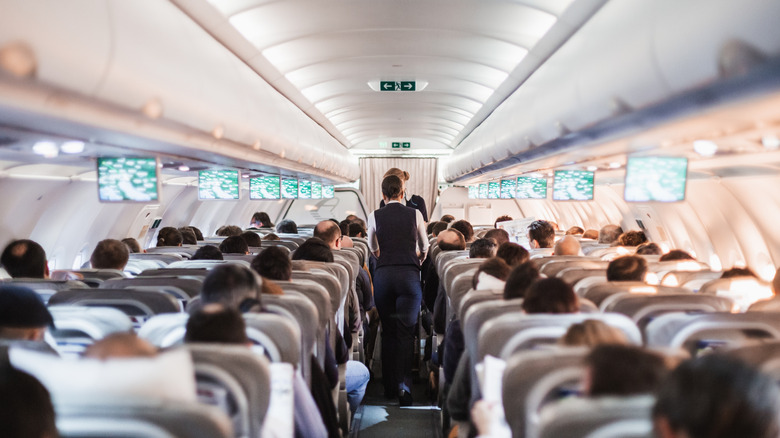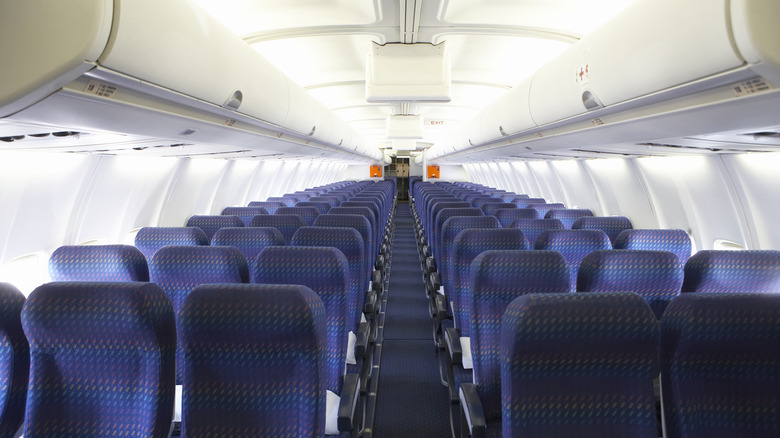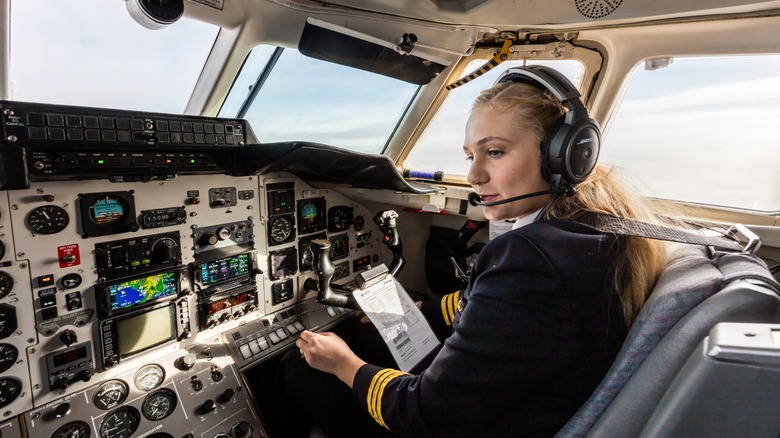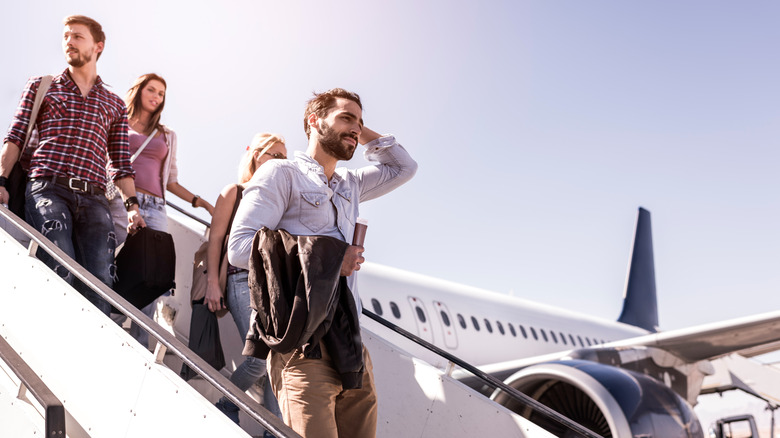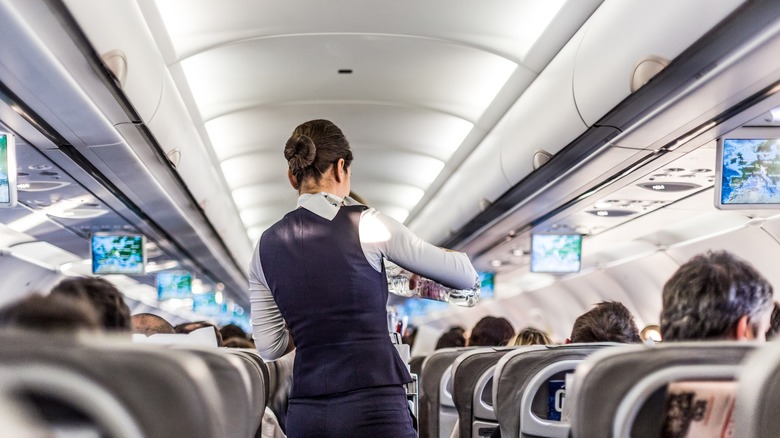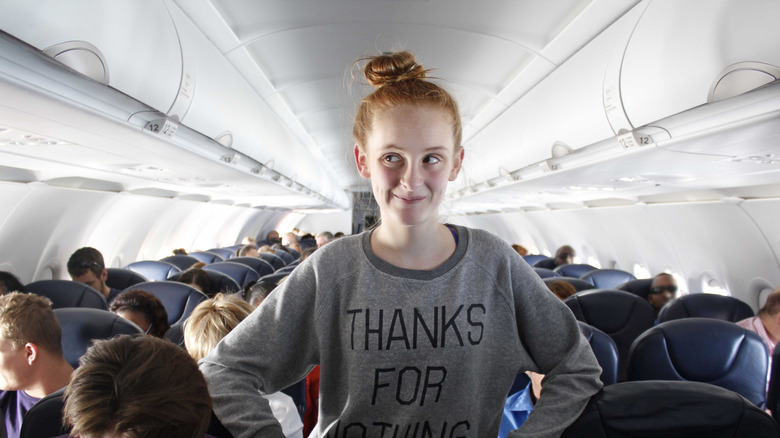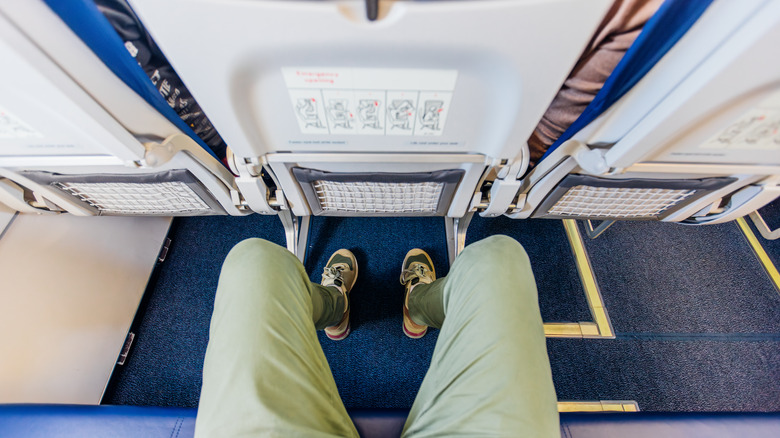These Are The Absolute Worst Seats On A Plane
Although commercial air travel has only been around for a little over a century, it has quickly changed the way we experience the world and the opportunities that come with it. Since then, airplanes have gone through multiple evolutions and prices for passenger flights have slowly become more affordable, even for the average person. On the other hand, cheaper flights can be a little like a double-edged sword, especially because some aspects of the flight experience can be compromised. While it's now possible to book flights online, there are tons of things you should consider to make sure you don't have a horrible in-flight experience, such as where you decide to sit.
Unless you splurge for first class, business class, or suites, you'll usually get what you pay for in the grand hierarchy of airline seating arrangements. This can impact anything from how comfortable the seat is, the amount of noise you're exposed to, how far you can recline your seat, and even how long it will take to get off the plane. So, how do you avoid the worst seats on the plane? It's important to note that "worst" is relative, especially because we all have individual preferences and needs when it comes to flying commercial airlines. However, there are quantifiable reasons why some airplane seats are just not as good as others. Here are a few of them.
The worst airplane seats for comfort
In a statement to Smarter Travel, David Duff, a former SeatGuru content specialist, shares that the last row is "more than likely going to have limited recline" compared to other seats. In addition, he shared there are also additional inconveniences associated with being near the galley, which include the sounds coming from the preparation for food service by the crew and the walking back and forth between passengers requesting their presence.
Apart from this, Duff also mentions that you might not be able to enjoy the view because of the lack of windows. This depends on the type of airplane you are riding, so you'll need to check your specific plane to see if there is a window or not, and it won't necessarily be a problem if you don't plan to look out the window anyway or if you are flying late at night and just plan to sleep through the entire flight.
That said, there are some situations wherein the last row can be your ideal airplane seat. If you have mobility issues or require regular assistance from the crew, being physically closer to them can help them see to your needs much more efficiently. Alternatively, if you have a medical condition that requires you to frequently go to the restroom, the last row (or seats near it) are good options to avoid disturbing other passengers with constant movement.
The airline seats with the worst turbulence
Although pilots try their best to avoid bad weather, experiencing air turbulence can be a right of passage for seasoned travelers. Unfortunately, air turbulence can be difficult to predict. In reality, the most you can do as an ordinary person is reserve the right seat so you can experience less of it and enjoy a relatively stable flight.
In an interview with Afar, airline pilot Maria Fagerström shares that "The best seats to experience the least amount of turbulence are close to the wings." So, if you're the kind of person who wants to have a good nap without the threat of being shaken like a martini, you might want to consider getting a seat near the exit row. Should all the seats near the middle of the plane be taken already (or where the center of gravity is), the next best option for a less turbulent ride will be at the front of the plane. In general, this portion of the plane is known to experience significantly less range of motion than the back area. But take note, just because the front of the plane will have less turbulence doesn't mean that it's less prone to danger.
The least safe seats on every plane
Despite news of plane crashes causing anxiety among travelers, the reality is that air travel is still one of the safest ways to travel. That said, if you still want to cover all your bases, it's possible to strategize and sit in the part of the plane that has historically shown passengers walking away alive from crashes. In 2015, Time reported that you're more likely to survive if you're seated in the back rows of the aircraft, based on 17 different seating charts from the Federal Aviation Administration (FAA). The study, which looked at accidents with casualties between 1985 and 2000, revealed that seats in the middle-third of the aircraft had the highest fatality rate.
It's important to note that pilots are trained to manage safety issues, including being able to land with just a single engine. So, while there are technically "safer" seats on a plane, you can rest assured that pilots go through rigorous training to be able to protect all of their passengers. Not to mention, while you can avoid planes with bad safety records when buying your ticket, it is still possible to experience last-minute aircraft changes on the day itself.
The worst seats for deplaning quickly
Unless you're riding on a tiny plane with exits on both the front and the back of the plane, chances are that sitting in the back seats of an airplane will mean you'll be one of the last to leave. For people who are aiming for connecting flights or want to be the first in line at the immigration counter, you'll want to avoid these seats like the plague. However, it's important to note that there are a lot of things that need to happen before you board and leave your aircraft, which can delay your deplaning more than where you sit.
In the past, we've mentioned how pilots wished more passengers realized that there's a lot that goes on behind the scenes of every single flight, regardless of whether you are sitting in the front or the back. Things like taking off and landing can still be delayed due to a variety of unforeseen reasons, like issues with the aircraft or traffic on the ground. While it can cause a lot of inconveniences, many people are working to make sure you get to your destination safely (even if it takes longer). On the flip side, if you're not in a hurry and don't have a connecting flight, getting a seat at the back of the plane can give you more time to relax while everyone is scrambling to get off as quickly as possible.
Ways to get better seats on planes (for free)
While tall people get a ton of advantages outside of planes, they're one of the primary victims of limited legroom space in budget airline flights. To manage this, the simplest solution for a more comfortable flight is paying for more premium seats with more space designed for longer legs. However, if this isn't within your budget, you can request an exit row seat during the check-in process. To do this, you'll need to be a good candidate for assisting the crew in an emergency, like being physically fit and willing to help. But if you check all the boxes, it can be worth the extra comfort.
In some cases, if you are celebrating some big life occasion like your birthday or honeymoon, some staff may also offer free upgrades. But this isn't guaranteed and subject to availability, so you can't assume you'll be able to get them, especially on particularly busy flights. Alternatively, you can request a bulkhead seat, as long as you don't need to access items directly in the seat in front of you frequently.
Despite decades of air travel, there are still a ton of cool high-tech features that we still don't get to experience in commercial flights. With time, we're hoping that things like wireless charging, high-speed internet, and better in-flight entertainment options become more common. But in the meantime, there are several things you can do to make flying less stressful.
Other factors that can ruin your in-flight experience
Although choosing the right airplane seat is a critical component of an enjoyable time in the air, there are a few other factors that can swing the pendulum between positive and negative. Similar to any public space, airplanes are full of different types of people who come from different walks of life and have their own quirks. Unless you book out entire rows, you wont be able to control everyone else in the flight with you.
In some cases, other guests just aren't informed about airline etiquette or simply don't know how to behave in public settings. In others, we may need to exercise some empathy, like with parents of babies or small children, who may not always be able to keep their little ones quiet for the duration of the entire flight. In fact, it's also possible that you just get unlucky, and the person next to you sounds like a truck when they snore, which can be beyond their realm of control.
In general, if you're encountering some particularly aggressive or difficult seatmates, you can always quietly reach out to the airline staff to help you. This can come in the form of managing the other passenger directly or moving you to another seat. In addition, you can pack some useful products in your carry-on that can help you manage these unexpected scenarios.
How to make flying on planes stress-free
In the past, we've shared some of our recommendations for essential long-haul travel gadgets, which include entertainment options, power banks, and even portable massage guns. Since you can't control the general temperature, it's also a good idea to dress in layers so you can add or remove things until you're comfortable. Plus, investing in some non-tech products like earplugs and neck pillows can also help you sleep better. Should you be a new parent, we have a couple of guides on the best gadgets for air travel with toddlers and essential tech for traveling with kids that you should check out. Similarly, people flying with the elderly or pets should also consult medical professionals for advice and do their research before any long flights.
There are so many factors you can't control when it comes to international air travel unless you fly private or learn how to fly an airplane yourself. If you really can't make do with having little control over your safety and experience in the clouds, you might want to consider doing long road trips instead. For some routes, this can mean taking significantly longer to reach your destination, but at least you'll have the option to make frequent stops and enjoy the view while you're at it. And, of course, unlike airplanes, there's a lot you can do to make a road trip more comfortable, as long as you prepare for it.
